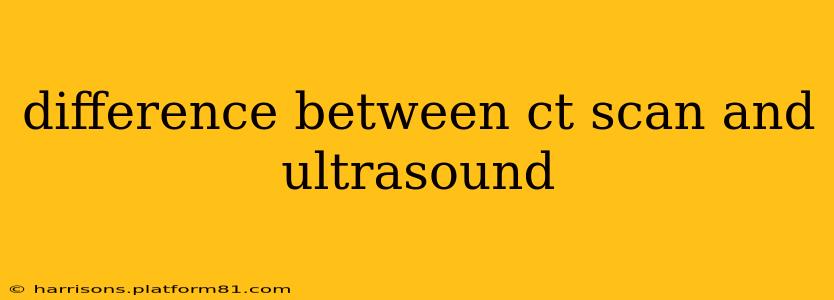Choosing between a CT scan and an ultrasound depends entirely on what your doctor is trying to diagnose. Both are valuable medical imaging techniques, but they utilize vastly different technologies and are best suited for different purposes. This guide will explore the key differences, helping you understand when each is appropriate.
What is a CT Scan?
A CT scan (computed tomography scan) uses X-rays to create detailed cross-sectional images of the body. A rotating X-ray machine takes multiple images from different angles, which a computer then combines to produce a 3D representation of the internal structures. CT scans are excellent for visualizing bones, internal organs, and blood vessels with high resolution.
Key features of a CT scan:
- Uses X-rays: Penetrates soft tissues and provides excellent bone detail.
- High resolution: Offers detailed images of internal structures.
- 3D imaging: Allows for visualization of structures in three dimensions.
- Radiation exposure: Involves exposure to ionizing radiation.
What is an Ultrasound?
An ultrasound (sonography) uses high-frequency sound waves to create images of internal organs and tissues. A transducer (probe) emits sound waves, and the echoes are detected and processed to create real-time images. Ultrasound is particularly useful for visualizing soft tissues, like muscles, organs, and blood vessels.
Key features of an Ultrasound:
- Uses sound waves: Non-ionizing radiation, making it safe for pregnant women and frequent use.
- Real-time imaging: Allows doctors to see movement and changes in real time.
- No radiation exposure: Completely safe procedure with no associated radiation risks.
- Less detailed than CT: Offers less detailed images than CT, especially for bone structures.
What are the main differences between a CT scan and an ultrasound?
The core differences lie in the technology used, the type of images produced, and the risks involved:
| Feature | CT Scan | Ultrasound |
|---|---|---|
| Imaging method | X-rays | High-frequency sound waves |
| Image detail | High resolution, excellent bone detail | Lower resolution, better for soft tissue |
| Image type | Static images, 3D reconstruction | Real-time, dynamic images |
| Radiation | Uses ionizing radiation | Non-ionizing, no radiation exposure |
| Cost | Generally more expensive | Generally less expensive |
| Preparation | May require fasting or contrast dye | Typically requires no special preparation |
What are CT scans used for?
CT scans are commonly used for diagnosing a wide range of conditions, including:
- Bone fractures: Clearly shows bone breaks and other injuries.
- Internal bleeding: Identifies bleeding within the body.
- Cancer detection: Helps identify tumors and assess their size and location.
- Lung conditions: Diagnoses pneumonia, emphysema, and other lung diseases.
- Abdominal injuries: Assesses injuries to the abdomen and internal organs.
What are ultrasounds used for?
Ultrasound is frequently used for:
- Prenatal care: Monitoring fetal development and detecting abnormalities.
- Abdominal imaging: Examining the liver, gallbladder, kidneys, and pancreas.
- Obstetrics and gynecology: Evaluating pelvic organs and pregnancy complications.
- Cardiac imaging (echocardiogram): Assessing heart function and structure.
- Vascular imaging: Evaluating blood flow in arteries and veins.
Which is better: CT scan or ultrasound?
There's no single "better" option; the choice depends on the specific medical situation. Your doctor will choose the most appropriate imaging technique based on your symptoms, medical history, and the suspected diagnosis. Ultrasound is often the preferred first choice for pregnant women or situations where radiation exposure should be minimized, while CT scans offer superior detail for bone and certain internal structures.
Is a CT scan harmful?
CT scans expose you to ionizing radiation, which carries a small risk of cancer. However, the benefits of a CT scan often outweigh the risks, especially when dealing with serious medical conditions. The amount of radiation varies depending on the specific scan and the area being imaged.
Does an ultrasound use radiation?
No, ultrasound does not use ionizing radiation. It uses sound waves, making it a safe procedure for all ages, including pregnant women.
Can I refuse a CT scan or ultrasound?
You always have the right to refuse any medical procedure, including a CT scan or ultrasound. However, it's crucial to discuss your concerns with your doctor and understand the potential consequences of refusing the procedure. They can explain the risks and benefits and help you make an informed decision.
This information is for general knowledge and does not constitute medical advice. Always consult your healthcare provider for diagnosis and treatment.
